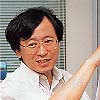- JST Home
- /
- Strategic Basic Research Programs
- /
 ERATO
ERATO- /
- Research Area/Projects/
- Completed/
- TOKURA Spin Superstructure
TOKURA Spin Superstructure

Research Director: Dr. Yoshinori Tokura
(Professor, Department of Applied Physics, The University of Tokyo)
Research Term: 2001-2006
During the 1900s, the discovery and development of quantum mechanics provided completely new insights into how we view atoms and molecules as well as systems of molecules, such as solid state crystals. This not only provided a very good way to understand these states of matter, but has also allowed an understanding of a wide range of interesting phenomena, like superconductivity and ferromagnetism, while providing a great assortment of devices and other applications. This effort continues today with a seemingly endless assortment of special conditions of matter.
A good example of this involves a type of condensed matter called transition-metal oxides, solids where the main atoms are oxides of the transition metals. These materials are also called correlated electron systems because there are many interacting electrons, compared to a doped semiconductor material. This type of system is also called an electron liquid, electron crystal, or even electron liquid crystal.
An electron in a solid that is bound to or nearly localized on a specific atomic site has three attributes: charge, spin and orbital. The orbital represents the shape of the electron cloud in the solid. In transition-metal oxides with anisotropic-shaped d-orbital electrons, the Coulomb interaction between the electrons (strong electron correlation effect) is important for understanding their metal-insulator transitions and properties, such as high temperature superconductivity and colossal magnetoresistance. The orbital degree of freedom occasionally plays an important role in these phenomena, and its correlation and/or order-disorder transition causes a variety of phenomena through strong coupling with charge dynamics. This will be a key concept for the science and technology of correlated electrons.
New terms, like “spin electronics” or “spintronics” have been coined to describe these new phenomena using the strong spin-charge coupling and orbital-charge coupling to produce some new electronic functionality or new electronics. A good example of this type effect is that if a magnetic field is applied to a material there is a large negative change in the resistance, as in manganese oxide compounds with a perovskite structure. The source of electron conduction is electron hopping, while also tending to maximize their magnetic moment. This conduction electron spin is always parallel to the local magnetic moment, and a source of a very strong electron spin- charge coupling. This spin-charge coupling can be used as a type of atomic switch of the conduction electrons. If a magnetic field is applied the magnetic moment becomes parallel, and the electrons can hop, and the material changes from an insulating state to a conducting state.
Yoshinori Tokura has shown that electron hopping on non-coplanar spin sites with spin chirality obtains a complex phase factor (Berry phase) in its quantum mechanical amplitude that acts as an internal magnetic field, and is predicted to manifest itself in the Hall effect and the magnetooptical Kerr effect. Combined work of transport measurement, neutron scattering, and theoretical calculations have provided evidence that the gigantic anomalous Hall effect observed in Nd2Mo2O7, a pyrochlore ferromagnet with a geometrically frustrated lattice structure, is mostly because of the spin chirality and the associated Berry phase originating from the Mo spin tilting. It is expected that further studies of this phenomenon will be productive concerning both basic science and device technology.
Outline of Research
The Tokura Spin Superstructure project is investigating both natural and new transition-metal oxide materials that exhibit strong electron correlation. Using the non-trivial texture of the spin should allow new functionality, since a tiny moderation of a subtle texture of the spin effects the motion of electrons in solids in a very profound way. This project is dedicated to probing the ultrafast magnetic-optical response of various materials using spin chirality. The research is divided into the following three areas:
An effort is being made to find naturally occurring materials that exhibit special spin textures on some type of topological lattices with conduction electrons. This effort is thus looking at well-known materials that have never been approached from the present perspective. An effort is also being made to fabricate new materials with the desired characteristics.
An effort is also being made to fabricate special spin textures, meaning that the spin superstructures change on the atomic scale. The best way to fabricate such a new spin superstructure is to use an epitaxy method. To this end, a type of molecular beam epitaxy method is being developed for producing these materials. Laser ablation is also being used. In this method a source target is prepared and then illuminated by light, allowing the ablation process to occur. Here, very thin films, are made with a superlattice by a layer-by-layer method. Thus, many spin textures can be made at the interfaces.
The third area involves new photonic effects, including ultrafast spin conversion. Using very fast light pulses an effort is being made to moderate the spin structure as well as the electronic response using very ultrashort pulses.


















